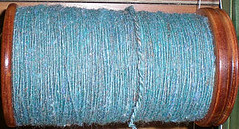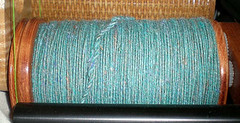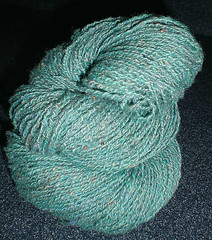 People are usually taught (and books usually say) to spin singles Z and ply S.
People are usually taught (and books usually say) to spin singles Z and ply S. However, you can and might want to consider the end-use for your yarn and the technique you’re going to use to get there.
Crochet prefers the final twist direction to be Z, since it adds Z twist to a yarn. So, if you were to take a final S twist yarn and crochet it, you’d be taking twist out ... and if it were singles, this could be a mess if the yarn then drafted apart again.
Knitting depends: British/throw-style knitting typically adds Z twist and German/Continental/pick-style knitting usually adds S twist. If you are doing twined knitting, your two strands will wrap around each other too ... no spinning style I know of can conquer that, except perhaps one of those yarn-ball-wrist-holder thingies that might let the ball unwind as you go, if you are working your Tvåändsstickning from both ends (grin). But I did note that S singles, Z ply is the recommended yarn for that method of knitting.
 I’ve heard that in weaving, if you weave with warp yarn with final twist S and your weft yarn with final twist Z, you get an interesting surface light reflection effect (good interesting, not odd interesting) though most of the weavers I know spin all the yarn for a project one way for both warp and weft.
I’ve heard that in weaving, if you weave with warp yarn with final twist S and your weft yarn with final twist Z, you get an interesting surface light reflection effect (good interesting, not odd interesting) though most of the weavers I know spin all the yarn for a project one way for both warp and weft.Nalbinders tend to disagree ... I used Z twist and did well with that, as my stitch technique added Z twist, but others report their technique adds S twist.
Now, for Kumihimo, Embroidery, Needlepoint, Cross-stitch, free lace, bobbin lace, hairpin lace, Tunisian crochet ... I’m afraid you’re on your own ;-)
 The two full bobbins above are an interesting study ... the top one is spun Z, the second one is spun S. Why'd I do that with the same fiber? All part of a ply experiment, for the "hemi-cable" yarn shown here.
The two full bobbins above are an interesting study ... the top one is spun Z, the second one is spun S. Why'd I do that with the same fiber? All part of a ply experiment, for the "hemi-cable" yarn shown here.ETA: You can tell the top is spun Z because the plied-back sample plies back S (the slant on the plying twist matches the middle bar of the letter S). And the lower is spun S, as the plied-back sample plies back Z -- the slant of the plying twist there matches the middle bar of the letter Z.
The yarn is spun from Three Bags Full Turquoise roving, spun S, plied Z with turquoise thread strung with real copper beads, and then plied S on another strand of Z-spun Turquoise. Whew!
If you've found direction of spin helpful in your fibery pursuits, I'd love to hear about it, especially if you can enlighten me about spinning for embroidery and the other methods. Thanks!
